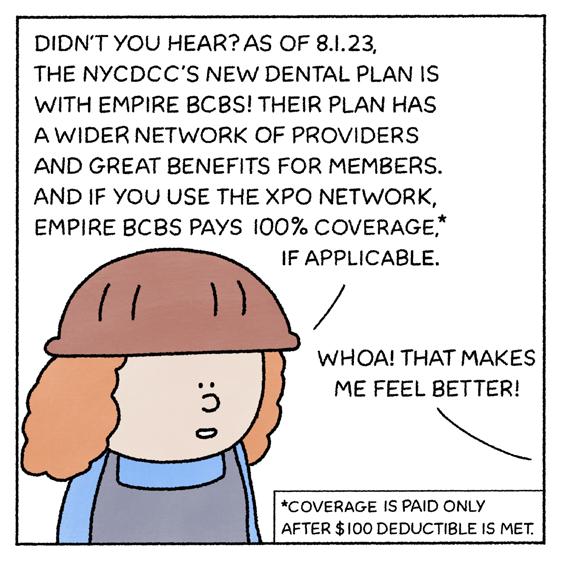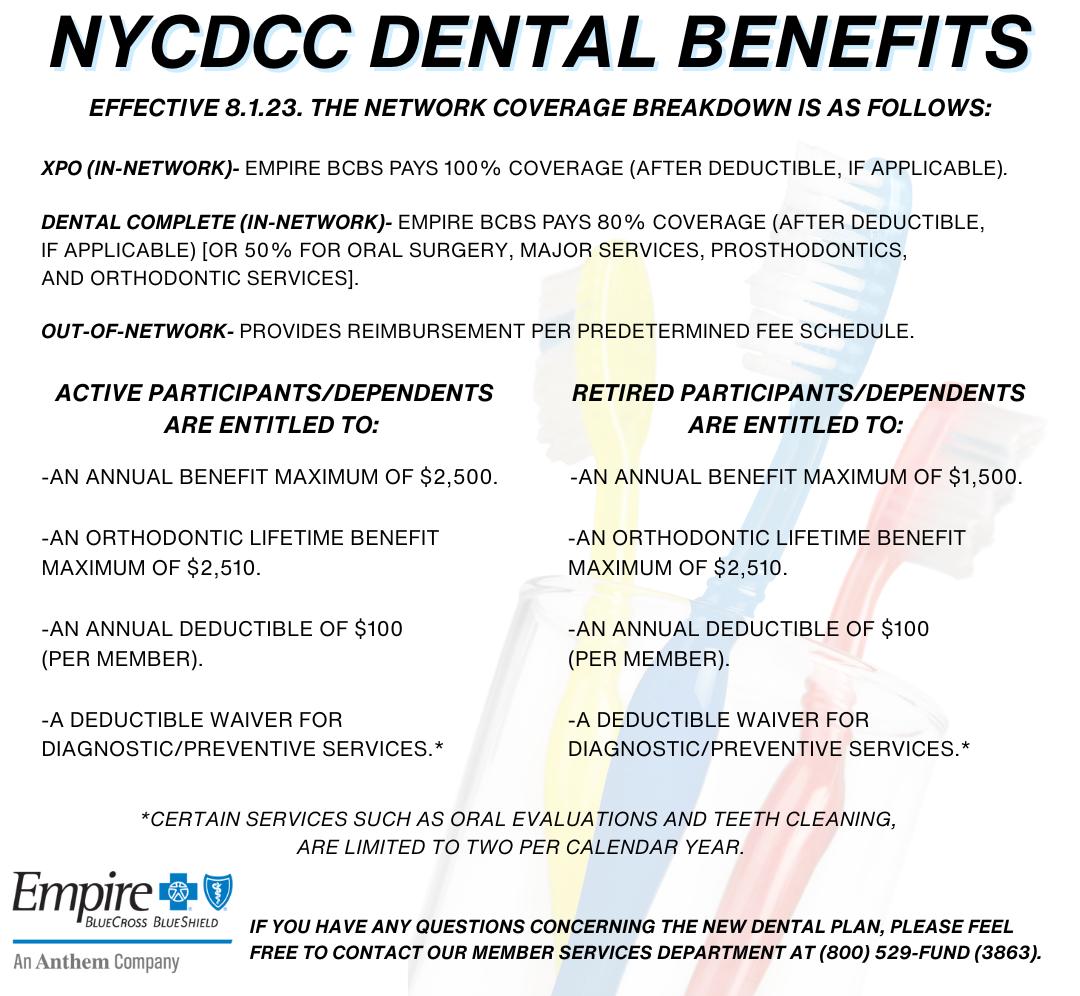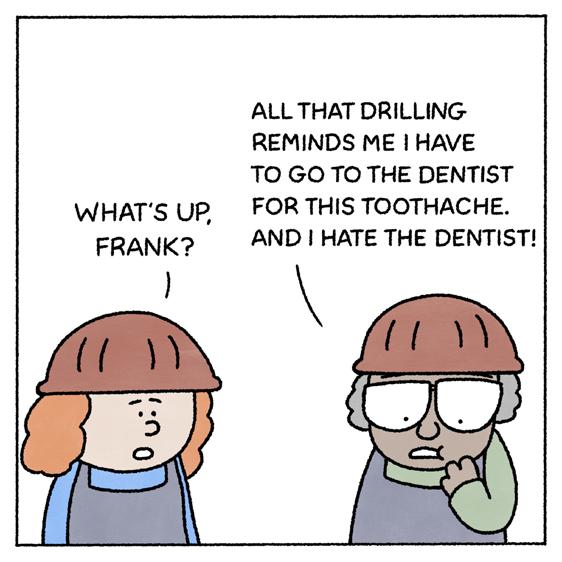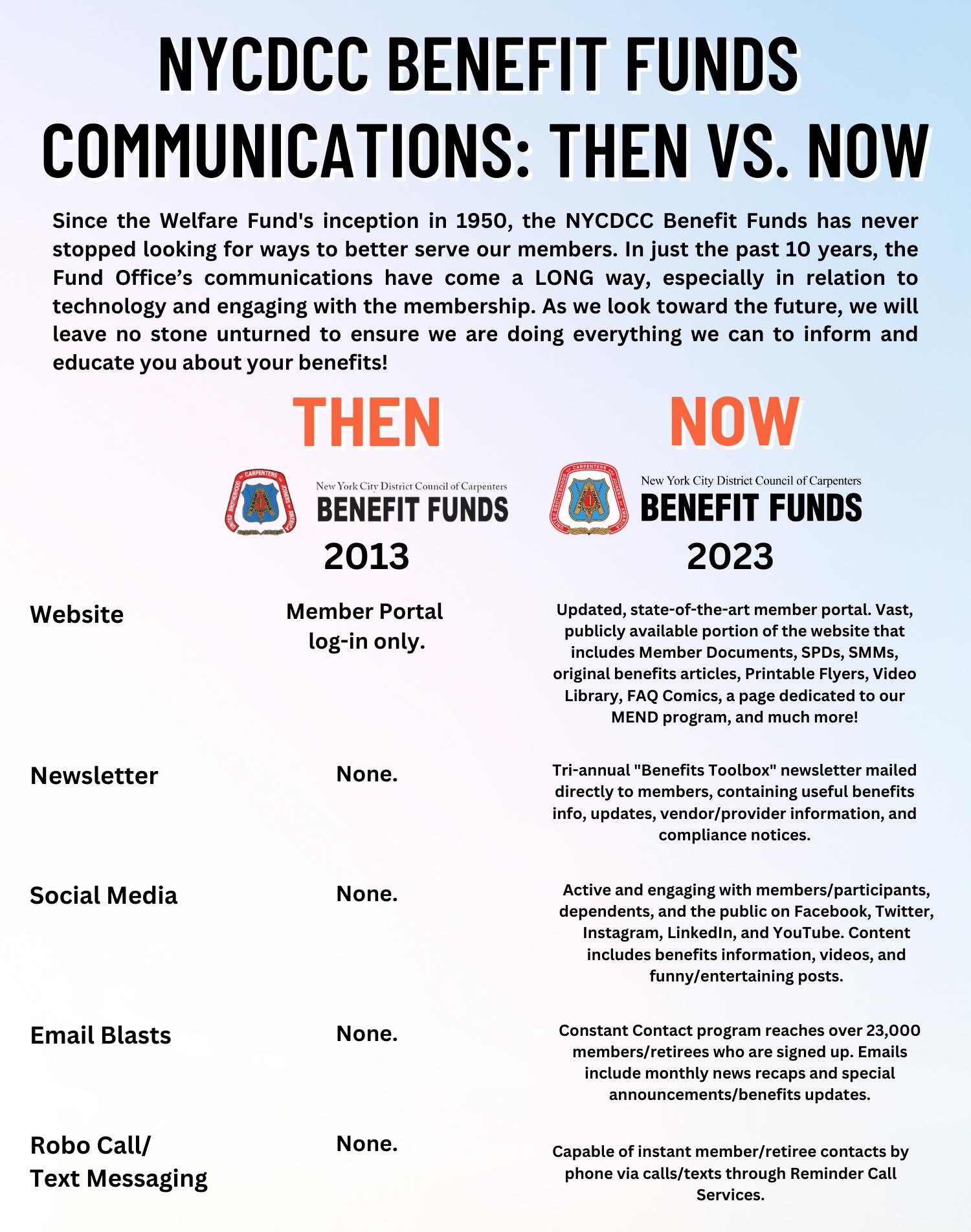BENEFITS TOOLBOX

NYCDCC Welfare Fund’s Board of Trustees Improves Dental Coverage, Changes Plan from ASO/SIDS to Empire BCBS
As previously reported on our website and social media pages, effective August 1, 2023, the NYCDCC Welfare Fund’s (the “Fund’s”) Board of Trustees improved dental coverage by changing the plan from Administrative Services Only, Inc./SelfInsured Dental Services (“ASO/SIDS”) to Empire BlueCross BlueShield XPO Dental Complete (“Empire BCBS”). We have summarized some information below to help you understand the new dental plan. You should have also received a package in the mail that contains a new Empire BCBS ID card (for dental coverage ONLY), as well as coverage details concerning the new plan.
Some highlights of the new dental plan through Empire BCBS include:

• A wider network of dental providers, including more abundant options for local providers, as well as those beyond the tri-state area. Our new plan has three types of coverage: (1) XPO (In-Network), (2) Dental Complete (In-Network), and (3) Out-of-Network. The network coverage breakdown is as follows:
- XPO (In-Network)- The Fund pays 100% coverage (after deductible, if applicable).
- Dental Complete (In-Network)- The Fund pays 80% coverage (after deductible, if applicable) [or 50% for Oral Surgery, Major Services, Prosthodontics, and Orthodontic Services].
- Out-of-Network- Provides reimbursement per predetermined fee schedule.
Active participants/dependents are entitled to:
• An Annual Benefit Maximum of $2,500.
• An Orthodontic Lifetime Benefit Maximum of $2,510.
• An Annual Deductible of $100 (per member)
• No Deductible for Diagnostic/Preventive Services (certain services, such as Oral Evaluations and Teeth Cleaning, are limited to two per calendar year).
Retired participants/dependents are entitled to:
• An Annual Benefit Maximum of $1,500.
• An Orthodontic Lifetime Benefit Maximum of $2,510.
• An Annual Deductible of $100 (per member)
• No Deductible for Diagnostic/Preventive Services (certain services, such as Oral Evaluations and Teeth Cleaning, are limited to two per calendar year).
• A fast-acting, reliable, and helpful Customer/Member Services Department that is equipped to handle significant call volume.
• An ability to transfer/continue coverage if treatment began with ASO/SIDS.
• An option for telehealth visits with dental providers.
• Emergency dental treatment for international travelers.
• Mobile and online tools to help make the most of your dental plan.
For more detailed information beyond these highlights, you can view the “Summary of Benefits” and the “Dental Provider Search” flyers, which can be found on our website at www.nyccbf.org. Additionally, you can manage your dental benefit at www.empireblue.com.
If you have any questions concerning the new dental plan, please contact our Member Services Department at (800) 529-FUND (3863) or Empire BCBS at the number located on the back of your ID card.

REMINDER: A Failure to Timely Report Your Divorce to the NYCDCC Welfare Fund May Result in Financial Liability to the Fund and Loss of Your Health Coverage
Failing to report a divorce and to remove your spouse (and any stepchildren) from your coverage under the NYCDCC Welfare Fund (the “Fund”) may result in grave financial repercussions and the loss of your health coverage, especially if your former spouse receives costly medical treatments after he/she is no longer eligible for coverage. Please read this explanation of the Fund’s rules and an example of how failing to follow these rules may impact you financially.
What a Divorce Means for your Former Spouse’s Coverage under the Fund - If you get a divorce, your former spouse is covered under the Fund only until the last day of the month in which the judge signs your divorce judgment. You must provide a copy of your divorce judgment to the Fund as soon as possible so that your former spouse’s coverage is terminated at the end of the month in which the judge signed the divorce judgment. You and your former spouse will be liable for any benefits paid on behalf of your former spouse after the last day of the month in which the judge signed the divorce judgment. In addition, in order for your former spouse to qualify for COBRA coverage, you or your former spouse must notify the Fund of your divorce within 60 days of the date of divorce. If the Fund does not receive notice of the divorce within 60 days of the divorce, (1) your former spouse will lose his/her COBRA rights and (2) you (along with your former spouse) will be personally liable for health claims paid by the Fund on behalf of your former spouse after he/she ceased to be eligible. Even if you think your former spouse has provided notice, we urge you to notify the Fund of your divorce to eliminate any doubts since you will both be responsible for repaying the Fund any claims paid in error. If you are a Retiree, your monthly premium will be reduced to reflect the removal of your former spouse from your Welfare Fund Retiree Coverage.
Example- Johnny Carpenter’s divorce judgment is signed by a judge on April 11, 2023. Under the rules of the Fund, Johnny’s ex-spouse Linda’s coverage under the Fund ends on April 30, 2023. (If notice of the divorce is provided within 60 days, Linda can elect COBRA coverage for up to 36 months.) However, neither Johnny nor Linda notifies the Fund of their divorce. In August of 2023, Linda becomes ill. She immediately has surgery and receives treatment over the next several months. Because the Fund has not been notified of the divorce, the Fund pays $85,000 in medical claims on behalf of Linda. In January of 2024, when Johnny wants to add his new spouse to his coverage, he finally notifies the Fund of his divorce. Under the rules of the Fund, Johnny and Linda must reimburse the Fund $85,000. Additionally, since the Fund was not notified of the divorce within 60 days, Linda no longer has the option to elect COBRA coverage. Unless full reimbursement is made, Johnny and his other dependents will immediately lose their Welfare coverage, and legal action may be taken against Johnny and Linda to recover the claims paid in error.
As you can see from this example, the failure to timely remove your ex-spouse from your coverage after your divorce can have severe consequences. Johnny may not have known that Linda was using her Fund coverage after their divorce, but he and Linda are jointly responsible for this debt because they did not timely notify the Fund of their divorce. By not notifying the Fund, Johnny is risking his financial security and continued health coverage for himself and his children. DO NOT put yourself in a situation where you could owe the Fund money and lose your coverage and your family’s coverage because you did not report your divorce in a timely fashion.
Remember -- While monthly COBRA premiums are expensive, they are far less expensive than incurring personal liability for claims and losing your coverage.
Sometimes a divorce judgment or settlement agreement requires one of the parties to pay the cost of their former spouse’s health coverage after the divorce. Such provision does not mean that your spouse remains eligible for coverage under the Fund (except through COBRA if timely elected) nor does it excuse you from the above-described notice obligations. Rather it means that you have financial responsibility for your former spouse’s health care premiums.
If you have questions about removing an ex-spouse from your coverage after a divorce, please contact our Member Services Department at (800) 529-FUND (3863).
ANNUAL REMINDER: “Breaks in Service” Can Impact Your Future Pension Benefits
Your service credit, pension calculation, and pension eligibility can be affected if your Covered Employment is interrupted before you have qualified for a vested benefit. The effect of such an interruption depends on whether the interruption is a “one-year break in service” or a “permanent break in service.” In addition, even if you are vested, a one-year break in service can disqualify you from being eligible for a Disability Pension.
One-Year Break in Service
You have a one-year break in service when you fail to earn at least one-quarter of a Vesting Credit (i.e., when you fail to work at least 300 hours) in a calendar year.
The following absences are not considered a break in service:
• Periods of qualified military service during which you are entitled to service credit under federal law
• Absence from work for maternity or paternity reasons due to pregnancy, the birth of your child, placement of a child with you in connection with an adoption, or to care for a child immediately following birth or adoption. Under this provision, up to one-quarter of a Vesting Credit is granted (i) in the year such absence begins, if necessary, to prevent a one-year break in service in that year, or (2) in the year following the year the absence began.
• If you receive a Disability Pension, recover, and return to Covered Employment before the end of the third month following the last month for which you received a Disability Pension, a special rule may help prevent a break that would otherwise occur in the calendar year in which you return to Covered Employment. As long as you have at least 300 Hours of Service in the 12-consecutive-month period immediately following the date you returned from disability, you will not incur a one-year break in the calendar year of your return.
• Qualifying periods of absence of up to 12 weeks under the Family and Medical Leave Act (FMLA) will not constitute a break in service if you return to employment in the period required under the FMLA.
Unless one of the rules above applies, periods of disability will NOT prevent a break in service.
Remember, if you have a one-year break in service before becoming vested, you will no longer be an Active Participant. If you have a one-year break in service after becoming vested, you will also cease to be an Active Participant, but you will be a Deferred Vested Participant.
Repairing a One-Year Break in Service
A one-year break in service may be temporary and subject to repair. If you return to Covered Employment and earn at least 870 Hours of Service within any two consecutive calendar years before you have a “permanent break in service,” your previously earned Vesting Credits and Benefit Credits will be restored.
One-Year Break in Service Example:
Tanya started Covered Employment in February 2019 and became a Plan Participant on January 1, 2020, after working 870 hours in 2019. Tanya earned 3 Vesting Credits as of December 31, 2021. Tanya did not work at least 300 hours in 2022 which resulted in a one-year break in service as of December 31, 2022.
If Tanya returns to Covered Employment and earns 870 hours over a consecutive two-year period before she has a permanent break in service, she will again become a Plan Participant and recover her 3 Vesting Credits.
(continued on page 4)
(continued from page 3)
Permanent Break in Service
If you have a permanent break in service, you will forfeit all of your Vesting Credits and Benefit Credits, and you will not be eligible to have that service restored.
If you have at least one Hour of Service on or after January 1, 1999, you have a permanent break in service if you have five or more consecutive one-year breaks in service and had earned fewer than five Vesting Credits before the break began.
When you have a permanent break in service, you permanently lose all Vesting Credits and Benefit Credits (and/or credit earned under the benefit formula) earned before the break and your participation is canceled. Your service credit cannot be restored even if you later become a Plan Participant.
Permanent Break in Service Example:
Phil started Covered Employment in March 2015 and became a Plan Participant on January 1, 2016 after working 870 hours in 2015. Phil has 2 Vesting Credits as of December 31, 2016. Phil did not work at least 300 hours in 2017 which resulted in a one-year break in service, and he did not return to Covered Employment in any year thereafter. Because Phil incurred five consecutive one-year breaks in service as of December 31, 2021, he permanently lost his 2 Vesting Credits. Phil’s credit cannot be restored even if he becomes a Plan Participant again in the future.
If you have questions concerning breaks in service and how they may impact your pension, you can view the Summary Plan Description on the Benefit Funds’ website at www.nyccbf.com/wp-content/ uploads/2016/06/Pension-SPD.pdf or you can call Member Services at (800) 529-FUND (3863).















